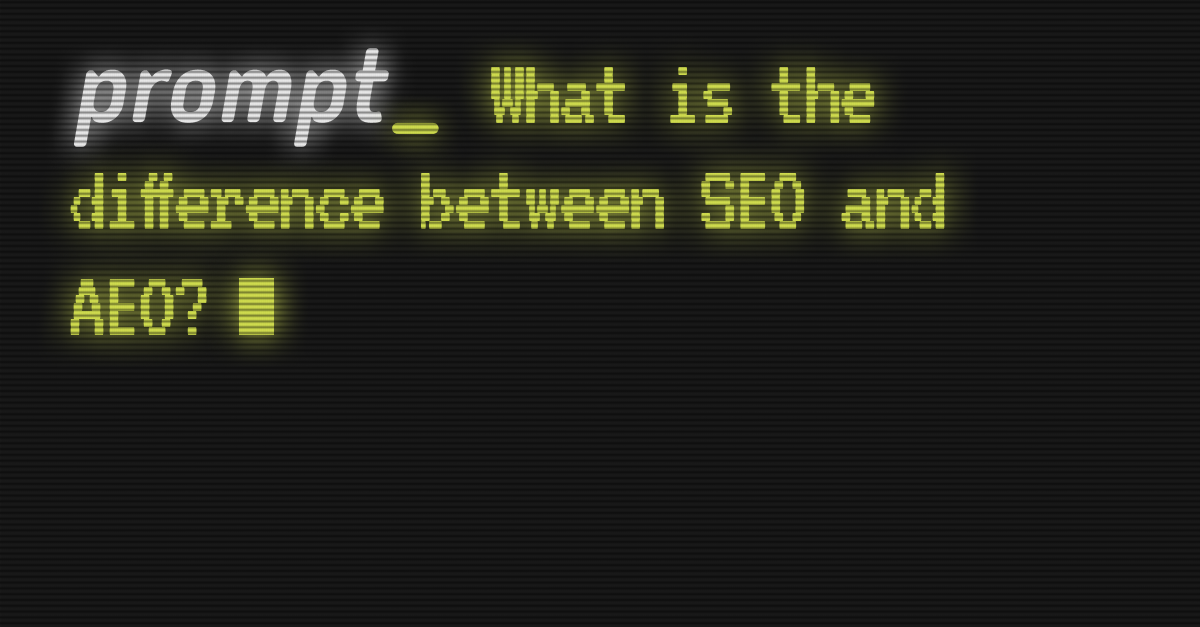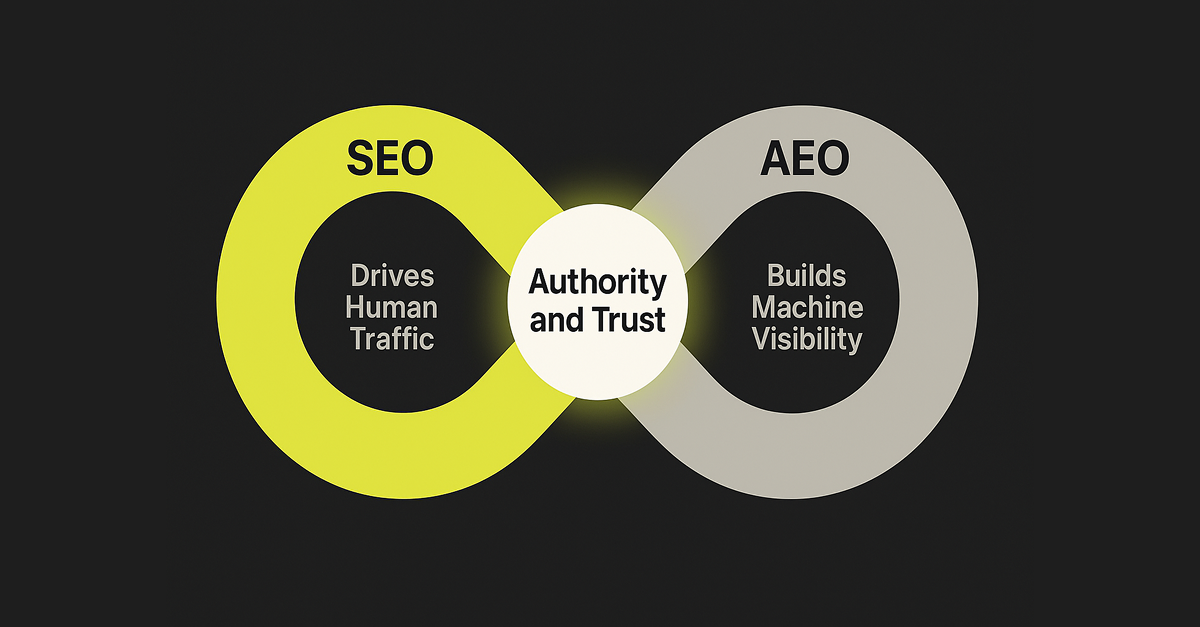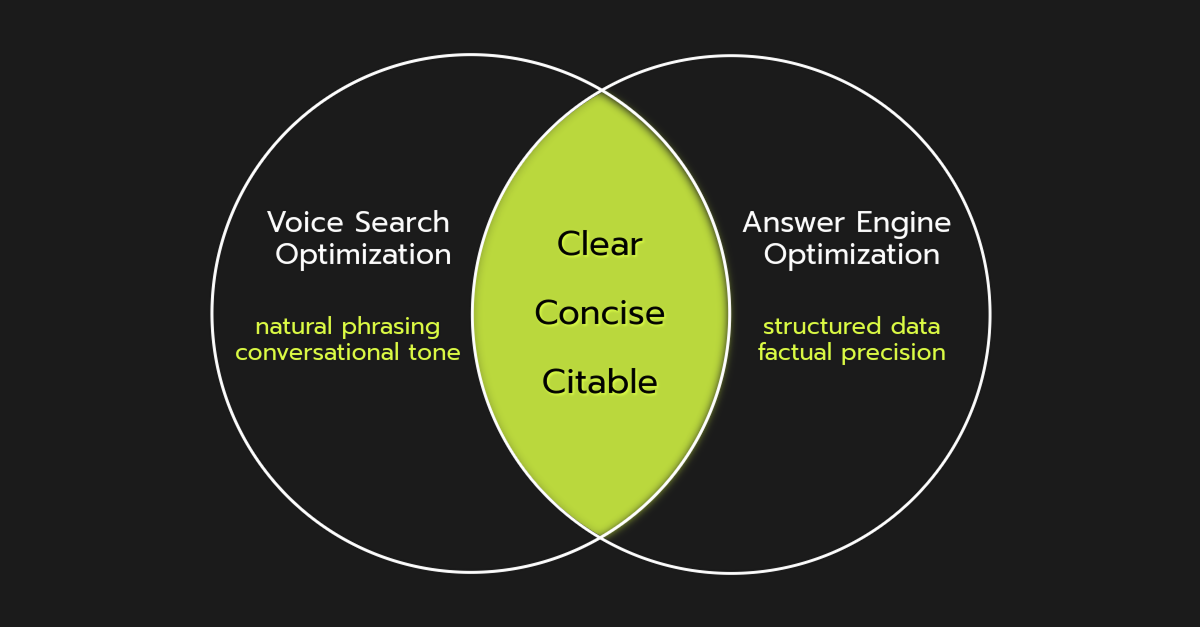What’s the Difference Between SEO and AEO?

Search has shifted. Humans still click, but AI systems increasingly generate the answers for them. Success in 2025 depends on visibility in both spaces: traditional rankings and algorithmic citations.
Overview
Search Engine Optimization (SEO) and Answer Engine Optimization (AEO) represent two sides of the same coin: human discovery and machine understanding. Traditional SEO helps your site rank for relevant queries, while AEO structures content so AI platforms such as Google AI Overviews, ChatGPT, and Perplexity can extract and cite it.
Did you know?
AI Overviews now appear in 13 percent of U.S. searches (Semrush, 2025). That means one in eight search experiences may never result in a click.
What is SEO and why does it still matter?
SEO aligns your content with user intent while removing technical barriers to discovery. It is about being found and being understood.
Core components include:
- Topical relevance through keyword alignment
- Technical health for crawlability and performance
- Authority signals through expertise and backlinks
Why do B2B companies rely so heavily on SEO?
SEO sustains visibility through long buyer cycles. Enterprise buyers often research for weeks before engaging with a sales team, and SEO ensures your content appears at every stage: awareness, consideration, and decision.
How does technical SEO support visibility?
Technical SEO builds the foundation for both human readers and machine interpretation.
Key focus areas:
- Core Web Vitals optimization to reduce friction
- Strategic internal linking that clarifies topical relationships
- Canonical and structured data tags to eliminate ambiguity
What is answer engine optimization (AEO)?
AEO prepares content for AI systems to extract, summarize, and cite directly. It is less about ranking and more about representation, ensuring your answers surface when AI tools respond to user questions.
How is AEO different from SEO?

Why does schema matter more now?
Structured data provides the explicit context AI systems need to identify authoritative sources. JSON-LD markup builds the scaffolding for AI comprehension.
How should schema be implemented for AI search?
Build a connected knowledge graph rather than isolated markup blocks. Link your Organization to Article to Author entities to create explicit relationships that AI can follow. Microsoft and Google emphasized this connected schema approach in 2025 because it helps AI validate both authority and context at the same time.
What schema types matter most for SEO and AEO?

Note: FAQPage and HowTo schemas are no longer supported for Google rich results but still help structure content for other engines and AI tools.
How do SEO and AEO work together?
The most effective strategies combine both:
- SEO attracts qualified human visitors.
- AEO converts visibility into citations and authority.
Why does SEO and AEO integration matter?
SEO and AEO integration matters because traffic and citations strengthen each other over time. Ranking builds trust while citations build reach. When AI systems repeatedly reference your brand, visibility compounds even without direct clicks.

How do you measure AEO performance?
Unlike SEO, AEO does not yet have a single dashboard. Measurement requires assembling data from multiple tools.
Key tracking methods:
- AI platform monitoring: Semrush AI SEO Toolkit or OmniSEO for brand mentions in ChatGPT, Perplexity, and Copilot.
- Featured snippet ownership: Track performance in Google Search Console.
- Zero-click impressions: Filter queries with impressions but no clicks.
- Conversion rate analysis: Compare GA4 segments for AI-sourced versus organic traffic.
Early research shows that AI-sourced traffic converts two to three times higher than traditional organic visits, reflecting stronger intent and trust.
How can B2B tech companies leverage AEO?
Enterprise buyers consume extensive information before contacting sales, often ten or more content pieces. When your explanations power AI responses, you gain early credibility.
Why is AEO particularly valuable for B2B?
AEO is valuable for B2B because visibility in AI answers positions your brand as a trusted expert before a human ever reaches your site.
Priority B2B content types include:
- Product comparison tables that AI can easily extract
- Integration guides with structured technical data
- Use case definitions matching voice and AI query phrasing
- ROI frameworks summarizing measurable impact
How does voice search fit into the picture?
Voice interfaces change how users phrase questions and how AI interprets them.
How long are voice-based responses on average?
Voice search results average 29 words in AI-generated responses, drawn from concise structured content (Backlinko analysis of 10,000 voice searches).
To optimize:
- Write full-sentence answers that sound natural aloud.
- Lead with definitions in the first 40 to 50 words.
- Test your content by reading it out loud.
How can you test voice-readiness more effectively?
Ask ChatGPT, Perplexity, or Gemini the questions your content answers. See which competitors are cited, then analyze their phrasing and structure to refine your own.

Both SEO and AEO continue to evolve as AI systems reshape how people discover and trust information.
What are the key trends shaping SEO and AEO in 2025?
The future of visibility lies in connection, not keywords. Semantic clarity, generative search, and machine-readable E-E-A-T now determine whether your brand is found, cited, and trusted across AI-driven discovery.
Semantic search and entity clarity
AI models prioritize explicit entity relationships. Connecting your content to knowledge graphs through schema, internal links, and consistent naming enhances visibility.
Generative search expansion
AI Overviews in Google and Bing have doubled year over year, reshaping how users consume information. Brands with verified structure and strong author signals rise fastest.
E-E-A-T becomes machine-readable
Experience, Expertise, Authoritativeness, and Trustworthiness now influence AI citation eligibility.
How can you strengthen EEAT signals?
Include author credentials, cite primary sources, and integrate case studies or research. AI validates authority through the same cues humans do, only faster.
Key takeaways
- SEO builds discoverability through technical and content excellence.
- AEO structures answers for machine comprehension and citations.
- Connected schema and semantic consistency bridge the two.
- Voice optimization and E-E-A-T signals enhance credibility.
- Together, they secure visibility across both search engines and answer engines.
At Prompt Digital, we help brands translate complexity into clarity, building strategies that align human discovery with AI understanding. Because visibility is not just about being found, it is about being understood.
Daniela keeps Prompt running with clarity and momentum, managing internal operations, optimizing workflows in ClickUp, and leading the team’s social media presence. A SearchAtlas expert fluent in SEO and AEO best practices, she connects process and performance to keep every system, and story, aligned.











